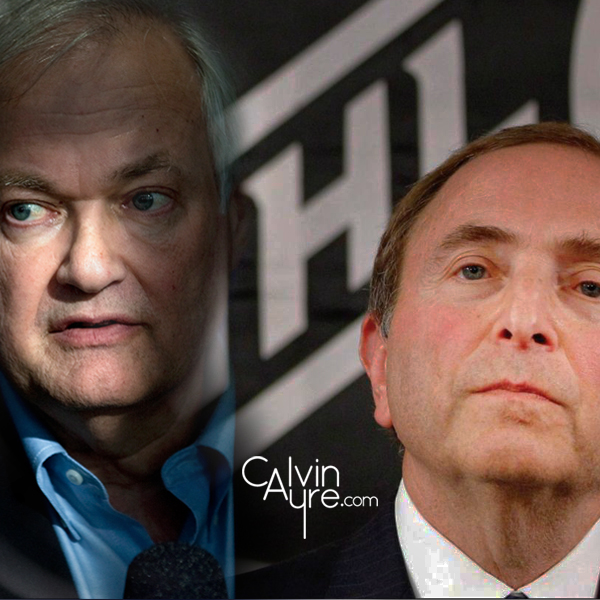The National Hockey League just entered Day 111 of its second work stoppage in the last eight years. The league locked its players out after the expiration of the collective bargaining agreement that had governed its interactions with the NHL Players’ Association for the previous seven years. Of all the professional sports player in North America, hockey is the only one ever to lose a season to labor strife. It’s now on the verge of losing a second season to the same malady.
 If you haven’t been paying attention, well, you’re not alone. Thanks to its insistence on a post-CBA sabbatical every eight years, the NHL is on the verge of running itself straight off the cliff of legitimacy. I only pay attention because I’m a diehard fan and I write a hockey blog. I haven’t been able to help noticing just how much the whole process has been like the final heads-up match in a big poker tournament.
If you haven’t been paying attention, well, you’re not alone. Thanks to its insistence on a post-CBA sabbatical every eight years, the NHL is on the verge of running itself straight off the cliff of legitimacy. I only pay attention because I’m a diehard fan and I write a hockey blog. I haven’t been able to help noticing just how much the whole process has been like the final heads-up match in a big poker tournament.
The two parties came to the table with different-sized stacks. The owners control the purse strings giving them the inherent advantage. Dependent on the owners to pay their salaries and pensions, the players still have a crucial ingredient without which there is no professional hockey: namely, a finely honed skill set that isn’t easily reproduced.
The full 2012-13 NHL schedule was doomed long before its first game was set to be played. Early on both the league (led by its commissioner, Gary Bettman) and the union (represented by Donald Fehr) stuck to predetermined strategies that ensured lots of game cancellations. Rather than actually negotiating with one another to prevent those cancellations, they postured aggressively for the media at every opportunity. Both presented the other with offers heavily slanted toward their own interests yet consistently declared themselves eager to get back to the business of playing hockey. If the other side agreed to concessions, great; if an offer was rejected, it was still possible to claim that an effort had been made.
All those bogus moves were just like the opening stages of a heads-up match. Success is often simply about projecting strength. Sometimes you’ll find yourself with a strong hand that can be played for value, but more often than not you’ll have a more marginal holding that can only be effectively protected by convincing the other guy that he really doesn’t want to tangle with you. Both the league and the union maintained their posture through December, when the inclusion of federal mediators wasn’t enough to come to any kind of agreement. After breaking off talks, Bettman’s number two man Bill Daly declared one of the league’s demands – a change to limit players’ contract rights – to be “the hill that we will die on.”
Though his rhetoric was of the fire-breathing variety, the fact is that Daly’s statement was one of the first moments where either side revealed weakness to the other. And that’s when the poker game moved on to its middle stage. In most heads-up matches there’s an inflection point where the players are required to shift their strategies to fit the new landscape. Sometimes it comes after one player has trapped the other with a strong but disguised hand, or one player misreads a situation and makes an aggressive but poorly timed play. Other times all it takes is winning a few smaller pots consecutively so that the balance of power shifts.
Then there are the matches where both players have similar styles and end up waiting so long to take control of the match that the blinds and antes advance to where neither party has as many options at his disposal – and that’s what happened in December. As the month advanced and there was no real attempt at progress from either side, both were inspired to make what at least appeared to be bolder plays than they had previously. Fehr asked the players to decide whether to give him authority to implement a “disclaimer of interest,” which would have the effect of breaking up the union for purposes of collective bargaining with the league. The league tried to forestall that tactic by filing a lawsuit – preemptively, no less – to block the players from taking that step. But rather than showing strength, they signaled a shift to the final stage of the game.
And that’s where my poker metaphor breaks down. In a poker game, pressuring your opponent when he’s down at the end of the tournament is the only strategy with a positive expected outcome. If you’re the big stack, you can never lose and sometimes you will even win if you’re forced into a showdown situation. If you’re the short stack, the blinds will devour your chips even if you don’t put them in play voluntarily. But in negotiations where both parties need each other, knocking the other player out simply isn’t an option. If you try to outlast the other guy you’ll only end up losing yourself. When you have to coexist in order to survive, the only strategy that makes any sense is making sure the other player stays in the game.
In order to play enough games to justify a season, players would have to be back on the ice before the end of January. As if acknowledging that reality, this week has seen a flurry of negotiating sessions between the two sides for the first time since the lockout began. Real progress reportedly has been made on a number of issues but there are also rumblings of mistrust among both NHL officials and union members. Neither side can afford for the other to lose, yet all of the tactics employed up to now have been suited to exactly that purpose. Playing this game out to its natural conclusion is essentially the only way to guarantee that nobody wins, and that’s as different from poker as you can possibly get. Whether the union and league realize that and come to an agreement that keeps both from losing remains to be seen.
